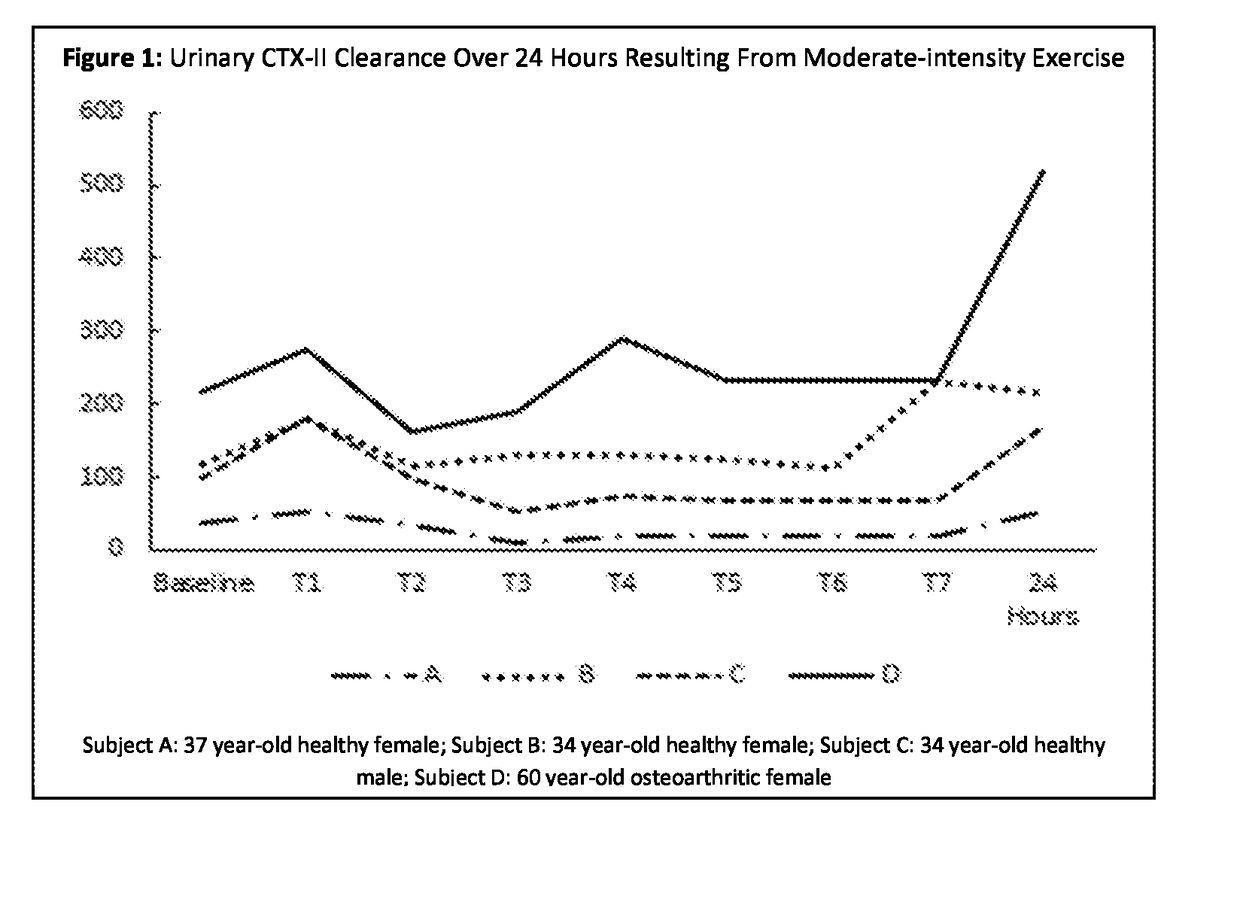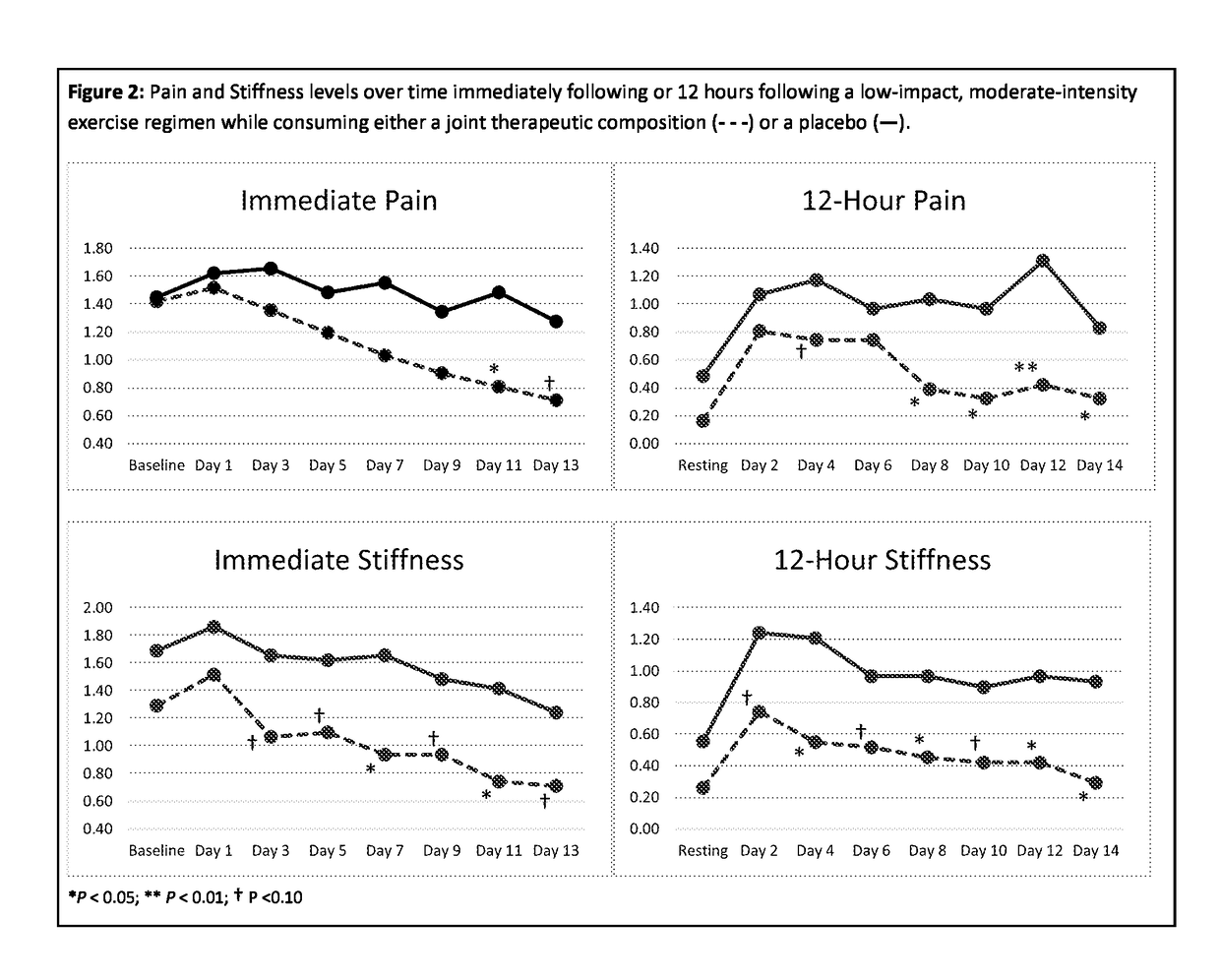Method for evaluating articular joint therapeutics
a technology for articular joints and therapeutics, applied in the direction of material analysis, biological material analysis, instruments, etc., can solve the problems of cartilage destruction, cartilage damage, and cartilage damage, and achieve the effect of reducing the change in cartilage degradation biomarkers
- Summary
- Abstract
- Description
- Claims
- Application Information
AI Technical Summary
Benefits of technology
Problems solved by technology
Method used
Image
Examples
example 1
tion of the Temporal Urinary Clearance of the Cartilage Degradation Biomarker CTX-II in Both Healthy and Arthritic Humans Over 24 Hours
[0057]The following example is illustrative of the determination of the temporal urinary clearance of the cartilage degradation biomarker CTX-II in both healthy and arthritic humans over 24 hours. Proteins in the bloodstream are known to be cleared over time by the human body via excretion in urine by the kidneys. This protein clearance occurs at different rates for different individuals and so an internal protein standard that is always present in urine, such as creatinine, is frequently used to normalize the clearance rates so that they can be compared between individuals or groups of individuals. Thus the ratio of urinary CTX-II, expressed in nanograms per deciliter (ng / dL), to urinary creatinine (Cr), expressed in millimoles per deciliter (mmol / dL) is calculated and the results are reported as nanograms of CTX-II per millimole of creatinine (ng / m...
example 2
of the Cartilage Degradation Biomarker CTX-II in Urine in an Arthritic, Post-Menopausal Human Female Resulting from a Low-Impact, Moderate-Intensity Exercise Regimen
[0061]The following example is illustrative of the increase of the cartilage degradation biomarker CTX-II in urine in an arthritic, post-menopausal human female resulting from a low-impact, moderate-intensity exercise regimen. CTX-II levels are reported as in Example 1 and were determined from the 2nd void of the morning collected within 12-24 hours after completing the last exercise. A post-menopausal female (age 58) with diagnosed osteoarthritis of the left knee who exercised fewer than 2 times per week provided a baseline urine sample for basal CTX-II level determination (119 ng / mmole Cr). The subject subsequently performed exercise for 7-10 minutes on alternating days for two consecutive weeks on a seated step machine (NuStep® brand) with a workload of 5.0 and a pace of approximately 70 steps per minute. At the end o...
example 3
of the Cartilage Degradation Biomarker CTX-II in Urine in a Healthy, Post-Menopausal Human Female Resulting from a Low-Impact, Moderate-Intensity Exercise Regimen
[0062]The following example is illustrative of the increase of the cartilage degradation biomarker CTX-II in urine in a healthy, post-menopausal human female resulting from a low-impact, moderate-intensity exercise regimen. CTX-II levels are reported as in Example 1 and were determined from the 2nd void of the morning collected within 12-24 hours after completing the last exercise. A post-menopausal female (age 67) with healthy knee joints (no knee pain or stiffness) who exercised fewer than 2 times per week provided a baseline urine sample for basal CTX-II level determination (156 ng / mmole Cr). The subject subsequently performed exercise for 7-10 minutes on alternating days for two consecutive weeks on an inclined treadmill with an incline of 14 degrees and a pace of 1.7 miles per hour. At the end of each week, the subject...
PUM
| Property | Measurement | Unit |
|---|---|---|
| time | aaaaa | aaaaa |
| distance | aaaaa | aaaaa |
| time | aaaaa | aaaaa |
Abstract
Description
Claims
Application Information
 Login to View More
Login to View More - R&D
- Intellectual Property
- Life Sciences
- Materials
- Tech Scout
- Unparalleled Data Quality
- Higher Quality Content
- 60% Fewer Hallucinations
Browse by: Latest US Patents, China's latest patents, Technical Efficacy Thesaurus, Application Domain, Technology Topic, Popular Technical Reports.
© 2025 PatSnap. All rights reserved.Legal|Privacy policy|Modern Slavery Act Transparency Statement|Sitemap|About US| Contact US: help@patsnap.com


